"Christmas Nuts, presented with a sound on film recording on a separate 16mm. film, produced by Paul Braun and Howard Goodman, is not only an interior color picture of exceptional beauty and impeccable technical quality but is also one of the best puppet films thus far created. With a camera technique paralleling that of the latest theatrical, animated talkie cartoons, the story of a wolf "hijacking" Santa Claus and the consequent near calamity for the two squirrels is unfolded in a completely cinematic fashion. The camera moves freely from medium shot to closeup, the mechanics of the sets are not obstrusive and the puppets move with agility and grace. The sets, which were designed and constructed with great care, are very handsome and exquisitely finished so that no imperfections are revealed in the enlarged picture of them on the screen. The sets, in combination with the colored lights used in part to illuminate them, embody the producers' theory of "created color." That is, no attempt is made to simulate nature, but rather to produce pleasing, vivid color combinations, as in the illustrations of a child's story book. A cleverly compiled dialog, song and music accompaniment has been synchronized with the picture, although recorded, at present, on a separate film." Movie Makers, Dec. 1935, 534.
"A man is practicing for a part in a play by covering his eyes with bandages and going through his daily life pretending to be blind." Sacramento Public Library.
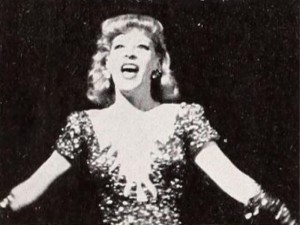
"Oscar H. Horovitz had, obviously, a certain amount of influence aiding his production of Follow the Girls, a motion picture study of the Gertrude Niesen musical comedy. This fact, however, does not explain the secret of his success. Others before him have had influence behind their filming of such dramatic spectacles as the circus, indoor ice carnivals, pageants and assorted stage shows. The influence did not help; their filming remained but a record, immobile and inanimate between the confines of a proscenium arch. Not so in Follow the Girls! Although executed with brilliant technical ability, the paramount triumph of this picture is its prevailing and sure sense of genuine cinematics. The cameraman seems to have been everywhere — on stage and off. Scenes of an ensemble or of a single singer cut in complete confidence from long shot to medium to closeup, without missing so much as a shoe tap. Follow the Girls, besides being lively and colorful entertainment, should serve as a model for all future personal movies of its kind and as an important record of this era of entertainment." Movie Makers, Dec. 1944, 477, 494.
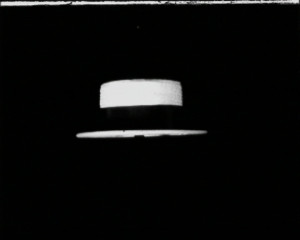
"Two theatrical agents, clearly averse to work, take pleasure in ridiculing the various performers who come to show their talents. The comedy turns slapstick as the agents unceremoniously dismiss the artistes, and even more so when the artistes subsequently take their violent revenge on the agents. The cine club shows its versatility by experimenting with a few camera tricks: at the beginning, with a spinning straw boater against a black background and later, during the sequences featuring 'Ricardo' the conjurer" (EAFA Database).
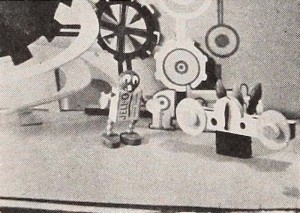
"Jello Again is an entertaining film, produced entirely by animation, that stands by itself even when the special work necessary to produce it is discounted. This Kodachrome subject, filmed by Carl Anderson, is made entirely in stop motion with puppet actors, an exceedingly difficult job. The excellence of the handling of the puppets and accessory properties, together with the imaginative quality of the settings, makes the subject an outstanding one. Here and there throughout the film, there are certain indications of unevenness in exposure on the "over" side, but, because of the real achievement embodied in the film as a whole, this very slight flaw may well be overlooked. The models used in the action were most cleverly constructed and colored, and the variety of camera angles employed was especially appropriate to the subject from the point of view of presenting the material advantageously." Movie Makers, Dec. 1939, 634.
"Made by Mr. And Mrs. Chambers to advertise tea and to stimulate tea-drinking across Canada, and accompanied by a narrative by Mrs. Chambers, in English for English-speaking audiences and in French for French-speaking audiences. The equipment to make the film was loaned by the Dunne and Rundle camera shop in Vancouver, where the film was made.
"The puppet story is about a Princess who mysteriously falls asleep with an unknown disease, and her father, the King, who sends far and wide to discover a cure. Finally the Princess is revived with tea and the young man who brings it to her is rewarded with her hand in marriage. The sponsor of the film was the old Empire Tea Bureau, for whom the Chambers' worked during the 1930s." (Colin Browne, Motion Picture Production in British Columbia, 1898-1940 (1979), entry #0872.)
The film is listed in Browne's filmography as "Tea Bureau Puppet Show."
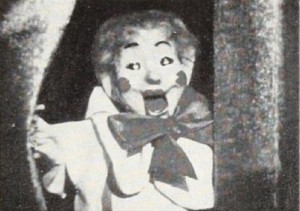
"The construction and performance of marionettes are skillfully pictured in Life Hangs By A Thread, by Paul R. Elliott and Joseph Dephoure. Aided by skillful lighting, a fine sound track perfectly harmonized with the action and an intelligent script, interest is closely held from the time a marionette is a lump of putty to its moments of glory when, in the hands of an experienced operator, it seems to take on a life of its own. Perhaps the most impressive thing about Life Hangs By A Thread is its careful step by step planning, indicating the sound belief by its producers that a movie should tell as much as possible pictorially, with the commentary used only to enhance the visual appeal." Movie Makers, Dec. 1948, 475-476.
"Puppets have gained favor and interest among amateur filmers and Mr. and Mrs. Frank Kallenberg have done a right smart job with a table full of animals from the forest. The story opens with a monkey in a rocking char, reading his cook book. He turns the page to the recipe for ducks. This stimulates him to seek a duck, the capture of which creates quite an uproar among the animals. In the end, Mr. Monkey becomes aware of the error of his ways. This type of work is tedious and painstaking and these filmers have demonstrated their patience and skill in the movement of the many characters in telling a homey little story." PSA Journal, Nov. 1957, 33.
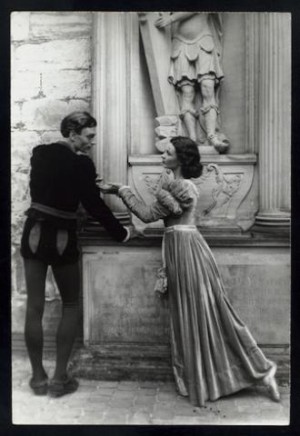
"Silent amateur film shot by John V. Hansen, engineer and member of the Amateur Cinema League, of a performance of Tyrone Guthrie’s Hamlet at Kronberg Castle, Elsinore, Denmark with Laurence Olivier as Hamlet. The first title card states that ‘the oldest metropolitan daily Berlingske Tidende of Copenhagen presents the Old Vic at Kronberg’. The second title states ‘snappy colour-shots from different angles of Scenes from Shakespeare’s ‘Hamlet’'. Film shows audience, cast getting ready and shots taken throughout the play" The Human Studies Film Archive via the British Universities and Film Council.
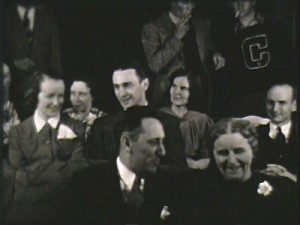
"Brief 1938 film of family and friends descending stairs into the cellar, followed by pan across the seated audience." oldfilm.org
Total Pages: 2